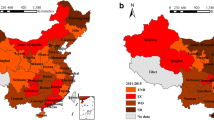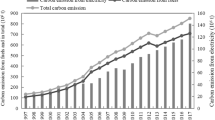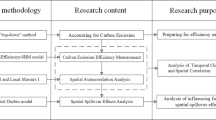Abstract
Both the realization of the “double carbon” goal and the low-carbon economy development requires a focus on transportation CO2 emissions. Calculating Chinese transportation CO2 emissions and exploring its principles are essential for achieving high-quality development of the transportation industry. Firstly, we use a “top-down” method to assess carbon emissions from transportation operations from 2003 to 2019. Secondly, the study decomposes the influencing factors of transportation CO2 emissions in China using the log-average weight decomposition method. Thirdly, the Tapio decoupling model is applied to study the decoupling effect of transportation CO2 emissions in each province of China. The findings suggest that China’s transport carbon emissions are growing at an annual rate of roughly 16%. All GDP per capita, transportation energy intensity, and population size increase the growth of transportation CO2 emissions. Contrastly, energy use per unit of turnover and transportation intensity decrease the growth of transportation CO2 emissions. There is much variation in China’s carbon emission decoupling index from year to year. Policy recommendations are proposed in response to the study of the above findings and the differences in carbon reduction potential among provinces.




Similar content being viewed by others
Data availability
All data used in this paper are from field research, then they are reliable and available.
References
Ang BW, Xu X, Su B (2015) Multi-country comparisons of energy performance: the index decomposition analysis approach[J]. Energy Econ 47:68–76
Azlina AA, Law SH, Mustapha NHN (2014) Dynamic linkages among transport energy consumption, income and CO2 emission in Malaysia [J]. Energy Policy 73(10):598–606
Cohan DS, Sengupta et al (2016) Net greenhouse gas emissions savings from natural gas substitutions in vehicles, furnaces, and power plants[J]. Int J Global Warming 14:2405
Engo J (2018) Decomposing the decoupling of CO2 emissions from economic growth in Cameroon[J]. Environ Sci Pollut Res 25(35):35451–35463
Freitas L, Kaneko S (2011) Ecol Econ 70(8):1459–1469
Guo B, Geng Y, Franke B et al (2014) Uncovering China’s transport CO2 emission patterns at the regional level[J]. Energy Policy 74:134–146
Huang G, Wang Z, Shi P, Zhou Y et al (2021) Measurement and spatial heterogeneity of tourism carbon emission and its decoupling effects: a case study of the Yellow River Basin in China. China Soft Science 4:82–93. (in Chinese)
IEA (2009) Transport, energy and CO2: moving toward sustainability[M]. IEA Paris
IEA (2018) CO2 emissions from fuel combustion [R]. IEA, Paris
IPCC (2013) Climate change 2013: the physical science basis. Contribution of working group to the fifth assessment report of the Intergovernmental Panel on Climate Change[M]. Cambridge University Press, Cambridge
Jaehun S (2017) The influence of new carbon emission abatement goals on the truck-freight transportation sector in South Korea[J]. J Clean Prod 164:153–162
Li M, Huang Y, Zhu W et al (2021) Research on the carbon emission total factor productivity of the transportation industry in China based on the global malmquist-luenberger index[J]. Science and Technology Management Research 2021(9):203–211
Li Y, Du Q, Lu X et al (2019) Relationship between the development and CO2 emissions of transport sector in China[J]. Transp Res 74:1–14
Liu Y, Wu M, Mu R (2021) Carbon emission measurement, factor decomposition and low carbonization strategies of transportation industry in Tibet. J Tibet Univ 36(1):126–133 ((in Chinese))
Papiez M, Smiech S, Frodvma K (2021) The role of energy policy on the decoupling processes in the European Union countries[J]. J Clean Prod 318:128484
Shao H, Wang Z (2021) 2021 Spatial network structure of transportation carbon emission efficiency in China and its influencing factors[J]. China Popul Resour Environ 31(4):32–41 ((in Chinese))
Sikder M, Wang C, Yao X et al (2022) The integrated impact of GDP growth, industrialization, energy use, and urbanization on CO2 emissions in developing countries: evidence from the panel ARDL approach[J]. Sci Total Environ 837:155795
Song D, Song Q, Zhang Q (2022) An analysis of the driving factors of China’s transportation carbon emissions: based on decoupling theory and generalized fisher index decomposition[J]. Sci Technol Manag Res 42(11):216–228 ((in Chinese))
Tapio P (2005) Towards a theory of decoupling: degrees of decoupling in the EU and the case of road traffic in Finland between 1970 and 2001[J]. Transp Policy 12(2):137–151
Wan L, Wang ZL, Jhony N (2016) Measurement research on the decoupling effect of industries’ carbon emission: based on the equipment manufacturing industry in China[J]. Energies 9(11):921–938
Wang C, Wood J, Wang Y et al (2020a) CO2 emission in transportation sector across 51 countries along the Belt and Road from 2000 to 2014[J]. J Clean Prod 266:122000
Wang C, Zhao Y, Wang Y et al (2020b) Transportation CO2 emission decoupling: an assessment of the Eurasian logistics corridor[J]. Transp Res D Transp Environ 86:102486
Wang C, Yao X, Sinha PN et al (2022) Why do government policy and environmental awareness matter in predicting NEVs purchase intention[J]? Moderating role of education level 131:103904
Wang Q, Zhao Z, Zhou P et al (2013) Energy efficiency and production technology heterogeneity in China: a meta-frontier DEA approach. [J]. Economic Modelling (35):283–289
Xiao H, Yi D, Zhou M (2013) Research on the decoupling relationship between China’s industrial economic development and carbon emission[J]. Fujian Tribune 3:57–63. (in Chinese)
Xie P, Gao S, Sun F (2019) An analysis of the decoupling relationship between CO2 emission in power industry and GDP in China based on LMDI method[J]. J Clean Prod 211(20):598–606
Xie R, Fang J, Liu C (2017) The effects of transportation infrastructure on urban carbon emission[J]. Appl Energy 196(15):199–207
Xu B, Lin B (2017) Investigating the differences in CO2 emissions in the transport sector across Chinese provinces: evidence from a quantile regression model[J]. J Clean Prod 2017(175):109–122
Yang W, Li T, Gao X (2015) Examining the impacts of socio-economic factors, urban form and transportation development on CO2 emissions from transportation in China: a panel data analysis of China’s provinces[J]. Habitat International 49:212–220
Yu J, Da Y, Ou Y (2015) Analysis of carbon emission changes in China’s transportation industry based on LMDI decomposition method [J]. China J Highw Transp 28(10):112–119
Zeng X, Qiu R, Lin D, Hou X, Zhang L, Hu X et al (2020) Spatio-temporal heterogeneity of transportation carbon emission and its influencing factors in China. China Environ Sci 40(10):4304–4313 ((in Chinese))
Zhang G, Su Z (2020) Analysis of influencing factors and scenario prediction of transportation carbon emission in the Yellow River Basin. Manag Rev 32(12):283–294 ((in Chinese))
Zhang K, Liu X, Guo P, Fang J, Yao J et al (2019a) Spatial-temporal differences of CO2 emissions of transport sector in Beijing-Tianjin-Hebei region. Syst Eng 37(5):12–20 ((in Chinese))
Zhang L, Long R, Chen H et al (2019b) A review of China’s road traffic carbon emission[J]. J Clean Prod 207:569–581
Zhang YJ, Jiang L, Shi W (2020) Exploring the growth-adjusted energy-emission efficiency of transportation industry in China[J]. Energy Econ 90:104873
Zhu C, Gao D (2019) A research on the factors influencing carbon emission of transportation industry in “the Belt and Road Initiative” countries based on panel data[J]. Energies 12:2405
Zhu X, Li R (2017) An analysis of decoupling and influencing factors of carbon emission from the transportation department in the Beijing-Tianjin-Hebei area, China[J]. Sustainability 9(5):1–19
Funding
This research was funded by Shaanxi Provincial Social Science Foundation (Grant No. 2020R026), Shaanxi Province Natural Science Foundation (Grant No. 2021JQ-294 and 2020JQ-400), Key Scientific Research Project of Shaanxi Provincial Department of Education (Grant No. 21JT001), and the Fundamental Research Funds for the Central Universities (CHD 300102112604 and 300102112501).
Author information
Authors and Affiliations
Contributions
J.C. and S.M. designed the research and wrote the paper. H.J., W.J., and Z.B. revised the paper. All authors have read and agreed to the published version of the manuscript.
Corresponding author
Ethics declarations
Ethical approval
All analyses were based on previous published studies, thus no ethical approval are required.
Consent to participate
All of the authors consent to participate in this paper.
Consent for publication
All of the authors consent to publish in this paper.
Conflict of interest
The authors declare no competing interests.
Additional information
Responsible Editor: V.V.S.S. Sarma
Publisher's note
Springer Nature remains neutral with regard to jurisdictional claims in published maps and institutional affiliations.
Rights and permissions
Springer Nature or its licensor (e.g. a society or other partner) holds exclusive rights to this article under a publishing agreement with the author(s) or other rightsholder(s); author self-archiving of the accepted manuscript version of this article is solely governed by the terms of such publishing agreement and applicable law.
About this article
Cite this article
Cai, J., Ma, S., Ji, H. et al. Spatial–temporal characteristics and decoupling effects of China’s transportation CO2 emissions. Environ Sci Pollut Res 30, 32614–32627 (2023). https://doi.org/10.1007/s11356-022-24470-y
Received:
Accepted:
Published:
Issue Date:
DOI: https://doi.org/10.1007/s11356-022-24470-y




